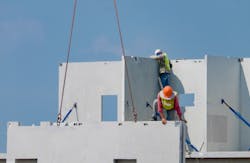How Alternative Building Systems Are Helping a Strained Workforce
Inflated materials prices, supply chain disruptions, and labor shortages are ushering in an era of adaptation for the building industry and creating more demand for concrete forms (ICFs), structural insulated panels (SIPs), and other energy-efficient systems, according to Green Builder. A survey conducted by NAHB last May revealed delayed delivery times and widespread shortages for the majority of respondents, causing many builders to seek out alternative construction systems.
Building envelope systems like ICPs, ICFs, and SIPs reduce onsite labor with pre-installed insulation and are also cost-efficient for their disaster resilience and energy efficiency at the same price of a stick-framed wall.
With ICPs, ICFs, and SIPs, the insulation is already in the wall when assembled, so one less trade is required. The required framing crew is about the same in terms of the number of people, but there is less handwork involved, meaning the job goes quicker.
“What makes ICFs so attractive is that they are cost-competitive with wood frame, steel frame, and masonry construction,” notes Lionel Lemay, executive vice president of structures and sustainability for the National Ready Mixed Concrete Association. “A building owner gets a building that is more disaster resilient and energy-efficient, at or nearly at, the same cost.”
